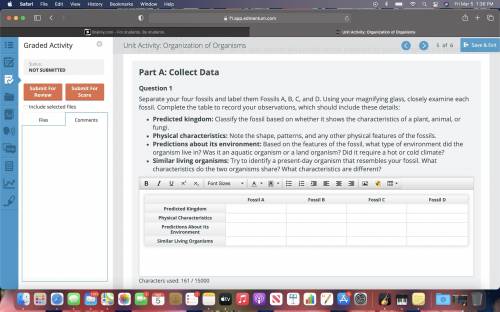30 points Part A: Collect Data
Question 1
Separate your four fossils and label them Fos...

Biology, 06.03.2021 01:00 samantha9430
30 points Part A: Collect Data
Question 1
Separate your four fossils and label them Fossils A, B, C, and D. Using your magnifying glass, closely examine each fossil. Complete the table to record your observations, which should include these details:
Predicted kingdom: Classify the fossil based on whether it shows the characteristics of a plant, animal, or fungi.
Physical characteristics: Note the shape, patterns, and any other physical features of the fossils.
Predictions about its environment: Based on the features of the fossil, what type of environment did the organism live in? Was it an aquatic organism or a land organism? Did it require a hot or cold climate?
Similar living organisms: Try to identify a present-day organism that resembles your fossil. What characteristics do the two organisms share? What characteristics are different?


Answers: 1


Other questions on the subject: Biology

Biology, 21.06.2019 14:00, alexialiles19
Which process must a cell undergo top identical cells at the end of cell division
Answers: 3

Biology, 22.06.2019 11:30, brayden2275
To store strawberries in sugar syrup, lucy placed them in a jar and covered them with sugar but did not add any water. do you think syrup will be formed? justify. a. no. since water is not added, there cannot be any syrup formation. b. no. the higher concentration of sugar on the outside will cause the water from the sugar to diffuse in the strawberry cells causing them to swell without formation of any syrup. c. yes. the higher concentration of sugar on the outside will cause the water from the strawberry to diffuse out resulting in syrup formation. d. yes. the sugar will melt over time and form the syrup.
Answers: 2

Biology, 22.06.2019 15:00, sparky1234
Which of th following is needed for cellular respiration to occur
Answers: 1

Biology, 22.06.2019 15:30, Calebmf9195
(me out over the last several centuries, scientists have made the following broad observations while investigating several branches of the life sciences: -the fossil record shows that different types of organisms have existed at different times in earth's history. -many organisms have similar body structures that seem to be adapted to different ways of living in their environment. -organisms of different species often share similarities in stages of embryonic development. -many species share genetic similarities, and almost all organisms use the same basic building blocks to construct proteins. -often, the extent of two species' similarities can be predicted from their geographic closeness to each other. -a great deal of change has been observed among species that have experienced strong selective pressures through many generations. scientists have carefully considered and rigorously tested the observations listed above. when scientists offer a of these observations, they are making 1.) testable explanation, deductive explanation 2.) scientific interference, scientific law
Answers: 3
You know the right answer?
Questions in other subjects:

Mathematics, 18.03.2021 01:40


History, 18.03.2021 01:40




Mathematics, 18.03.2021 01:40

Mathematics, 18.03.2021 01:40




